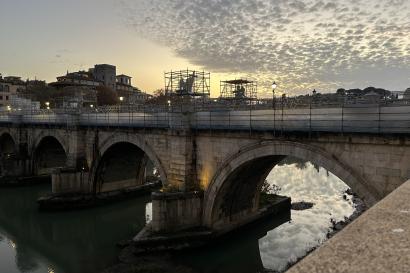If I had to pick a favorite class from this semester, it would definitely be my conservation class. As an Art History major I had heard of the act of conserving artworks, but I never learned about any of the specifics. This class opened my eyes to a whole other art form. Art conservation is the act of preserving a work of art. The concept of art conservation is amazing in itself, but learning and seeing the techniques first hand made it much exciting. For some reason that I can not figure out, the class is very small. Don’t get me wrong, I love having a small class because I feel like I learn so much more and it is so different from my classes back home, but I believe this class deserves more attention from art majors as well as non art majors.
Something that makes this class special are the unique field studies that we get to go on. Even though each of my classes takes us on field studies, none of them have had quite the impact that my conservation class’ do. For example, we frequently go to conservation sights in various churches throughout Rome. We also went to Villa Medici and got to go up on the scaffolding and see conservation work being done. But the field study that will go down as the best field study I’ve attended all semester was our field study to the Vatican Museum’s Conservation Labs. When we arrived at the museums, we went in our own entrance and bypassed all the lines. We then were given an escort who walked us through areas of the museum I have never seen before, and I’ve visited twice. We made our way to the first lab, the Ethnological Materials lab, which was a lab that has been open for 12 years and they work on artifacts and artworks that were donated to the Pope in the 1920s from countries all over the world. We were shown a Japanese work from the late 1500′s early 1600′s by the famous artist Yunpeng. To be in such close proximity to a work of art that was that old was a feeling I will never forget. We then saw a tapestry from China which was equally as old and amazing as the painting. The tapestry is so worn from bugs eating it away that they have to take it off of its cotton backing, and replace it with a new back. The lab is currently researching which type of material will work best with the fibers of the tapestry. Something I found interesting about this lab, is that even though it is located in Italy, they have to take the country of origins conservation techniques into consideration when conserving a work. They can’t just go ahead and do it the way they normally would in an Italian lab. After this lab, we walked to the painting lab and the metals lab. In the paintings lab they were working on old religious artworks as well as a large piece by Titian. Finally, after the metals lab we were shown the area that is working on Bernini’s original models for his bronze sculptures. I was in Art History heaven. Bernini has always been one of my all time favorite artists, so to be able to see one of his original models up close and personal was the highlight of the entire visit.
Along with lectures and field studies, we also participate in a fresco lab. During this lab, my classmates and I created our own frescos using the techniques we were going over in class. As a class, we decided to paint sections of Raphael’s fresco, The School of Athens, which can be found in the Vatican Museums. My group painted Plato, and the other group painted Aristotle. Our two lab professors are art conservationists here in Rome, and are currently working on the Villa Medici rooms that we visited earlier in the semester. It was so neat to really see what went into making a fresco. It is so much more than just painting on a wall. Even though Raphael definitely had better grasp of the fresco technique than we do, I think ours look pretty darn great.

This is a sketch of Plato that my group and I made that allowed us to then use the pouncing technique.

Here you can see the effect of the pouncing on the fresco. It creates an outline for the artist to follow.
If I could suggest any class for future IES Abroad Rome students, it would definitely be this class. Not only will you learn so much about the art, but also what goes in to making it, and you will get the rare opportunity to put the techniques to use.

Killian Gilvary
<p><span style="color: rgb(29, 29, 29); font-family: Arial, Verdana, sans-serif; font-size: 12px; line-height: normal; background-color: rgb(237, 237, 237);">I am currently a junior at the Pennsylvania State University, majoring in Art History and Criminology. I am an active member in the service sorority, Gamma Sigma Sigma, and I enjoy giving back to my community and school. In my free time, I enjoy photography, cooking, reading, and spending time with my friends. Traveling to Italy has always been one of my goals, and I have been lucky enough to receive the opportunity to study abroad in Rome. I look forward to seeing all of my favorite works of art in person, as well as being able to immerse myself in the Italian culture. I hope my blog will not only allow you to view my experience in Rome, but that it will also allow you to immerse yourself in the Italian culture through my photos.</span></p>














